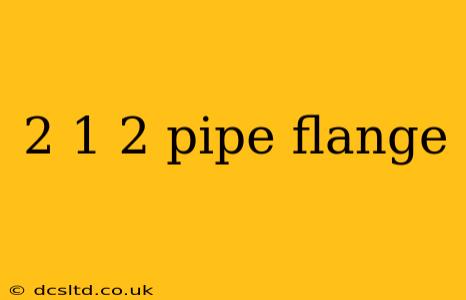Understanding pipe flanges, especially when dealing with specific sizes like a 2 1/2" pipe flange, is crucial for anyone working in plumbing, construction, or industrial settings. This comprehensive guide will delve into the specifics of 2 1/2" pipe flanges, clarifying their uses, types, and crucial considerations for safe and effective installation. We'll also address some frequently asked questions surrounding this specific flange size.
What is a 2 1/2" Pipe Flange?
A 2 1/2" pipe flange is a circular metal plate, typically made of steel, stainless steel, or cast iron, used to connect pipes. The "2 1/2"" refers to the nominal pipe size (NPS), indicating the inside diameter of the pipe it's designed to connect. It's important to note that the actual outside diameter of the pipe and the flange itself will be slightly larger. The flange provides a robust and reliable connection point, usually sealed with a gasket to prevent leaks. These flanges are essential components in various piping systems, ensuring the safe and secure transportation of liquids, gases, or other materials.
What are the Different Types of 2 1/2" Pipe Flanges?
Several types of 2 1/2" pipe flanges exist, each designed for specific applications and pressure requirements. Some common types include:
-
Slip-on Flanges: These flanges are easily slipped over the pipe end, then welded or bolted to the mating flange. They are relatively easy to install.
-
Weld Neck Flanges: These offer superior strength and are welded directly to the pipe, creating a robust and leak-proof connection, ideal for high-pressure applications.
-
Blind Flanges: These solid circular plates are used to cap off or close the end of a pipe.
-
Threaded Flanges: These flanges feature threads that allow them to be screwed directly onto threaded pipe ends, offering a simpler, faster installation than welding.
-
Socket Weld Flanges: These flanges are designed to be socket welded to the pipe, providing a strong and reliable connection suitable for higher pressures than slip-on flanges.
What are the Applications of a 2 1/2" Pipe Flange?
The versatility of the 2 1/2" pipe flange makes it suitable for a wide range of applications across various industries. Common uses include:
-
Water Supply Systems: Connecting pipes in residential, commercial, and industrial water systems.
-
Gas Pipelines: Securing connections in natural gas distribution networks.
-
Chemical Processing: Handling various chemicals and fluids safely and effectively.
-
HVAC Systems: Connecting pipes in heating, ventilation, and air conditioning systems.
-
Oil and Gas Refineries: A critical component in high-pressure pipelines and equipment.
What Material is a 2 1/2" Pipe Flange Typically Made From?
The material of a 2 1/2" pipe flange is chosen based on the application and the fluid being transported. Common materials include:
-
Carbon Steel: A cost-effective option for many applications.
-
Stainless Steel: Offers superior corrosion resistance, ideal for harsh environments or when handling corrosive chemicals.
-
Cast Iron: Used where high strength and pressure resistance are not critical.
How Do I Choose the Right 2 1/2" Pipe Flange?
Selecting the appropriate 2 1/2" pipe flange involves considering several factors:
-
Pressure Rating: The flange must be rated for the pressure of the system.
-
Material Compatibility: The flange material should be compatible with the fluid being transported.
-
Flange Type: The type of flange (slip-on, weld neck, etc.) should be selected based on the installation method and system requirements.
-
Gasket Material: The gasket material must be compatible with both the flange material and the fluid.
Where Can I Find a 2 1/2" Pipe Flange?
2 1/2" pipe flanges are widely available from industrial supply companies, plumbing suppliers, and online retailers specializing in industrial hardware. It is advisable to purchase from reputable suppliers to ensure quality and compliance with industry standards.
This guide provides a solid foundation for understanding the intricacies of 2 1/2" pipe flanges. Remember to always consult relevant industry standards and regulations when specifying, selecting, and installing these vital components in any piping system. Choosing the right flange is crucial for ensuring system integrity, safety, and longevity.
